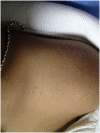Transcranial Direct Current Stimulation for Treatment of Childhood Pharmacoresistant Lennox-Gastaut Syndrome: A Pilot Study
- PMID: 27199889
- PMCID: PMC4854865
- DOI: 10.3389/fneur.2016.00066
Transcranial Direct Current Stimulation for Treatment of Childhood Pharmacoresistant Lennox-Gastaut Syndrome: A Pilot Study
Abstract
Background: Lennox-Gastaut syndrome (LGS) is a severe childhood epileptic syndrome with high pharmacoresistance. The treatment outcomes are still unsatisfied. Our previous study of cathodal transcranial direct current stimulation (tDCS) in children with focal epilepsy showed significant reduction in epileptiform discharges. We hypothesized that cathodal tDCS when applied over the primary motor cortex (M1) combined with pharmacologic treatment will be more effective for reducing seizure frequency in patients with LGS than pharmacologic treatment alone.
Materials and methods: Study participants were randomized to receive either (1) pharmacologic treatment with five consecutive days of 2 mA cathodal tDCS over M1 for 20 min or (2) pharmacologic treatment plus sham tDCS. Measures of seizure frequency and epileptic discharges were performed before treatment and again immediately post-treatment and 1-, 2-, 3-, and 4-week follow-up.
Result: Twenty-two patients with LGS were enrolled. Participants assigned to the active tDCS condition reported significantly more pre- to post-treatment reductions in seizure frequency and epileptic discharges that were sustained for 3 weeks after treatment.
Conclusion: Five consecutive days of cathodal tDCS over M1 combined with pharmacologic treatment appears to reduce seizure frequency and epileptic discharges. Further studies of the potential mechanisms of tDCS in the LGS are warranted.
Trial registration: ClinicalTrials.gov, NCT02731300 (https://register.clinicaltrials.gov).
Keywords: Lennox–Gastaut syndrome; cathodal stimulation; childhood pharmacoresistant epilepsy; transcranial direct current stimulation.
Figures



References
-
- Arzimanoglou A, Guerrini R, Aicardi J. Aicardi’s Epilepsy in Children. 3rd ed Philadelphia: Lippincott Williams & Wilkins; (2004). p. 38–50.
-
- Beaumanoir A. The Lennox-Gastaut syndrome: a personal study. Electroencephalogr Clin Neurophysiol Suppl (1982) 35:85–99. - PubMed
-
- Gastaut H, Dravet C, Loubier D, Glove C, Viani F, Gastaut JA, et al. Evolution Clinique et prognostic du syndrome de Lennox-Gastaut. In: Lugaresi E, Pazzaglia P, Tassinari C, editors. Evolution and Prognosis of Epilepsies. Bologna: Aulo Gaggi; (1973). p. 133–54.
Associated data
LinkOut - more resources
Full Text Sources
Other Literature Sources
Medical

